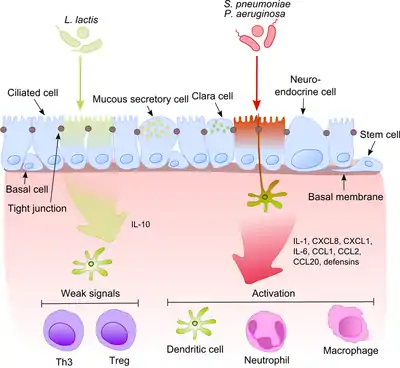Nonpathogenic organisms
Nonpathogenic organisms are those that do not cause disease, harm or death to another organism and is usually used to describe bacteria.[1][2] It describes a property of a bacterium - its ability to cause disease. Most bacteria are nonpathogenic. It can describe the presence of non-disease causing bacteria that normally reside on the surface of vertebrates and invertebrates as commensals. Some nonpathogenic microorganisms are commensals on and inside the body of animals and are called microbiota. Some of these same nonpathogenic microorganisms have the potential of causing disease, or being pathogenic if they enter the body, multiply and cause symptoms of infection. Immunocompromised individuals are especially vulnerable to bacteria that are typically nonpathogenic but because of a compromised immune system, disease occurs when these bacteria gain access to the body's interior. Genes have been identified that predispose disease and infection with nonpathogenic bacteria by a small number of persons.[3] Nonpathogenic E.coli strains normally found in the gastrointestinal tract have the ability to stimulate the immune response in humans, though further studies are needed to determine clinical applications.[4]

A particular strain of bacteria can be nonpathogenic in one species but pathogenic in another.[5] One species of bacterium can have many different types or strains. One strain of a bacterium species can be nonpathogenic and another strain of the same bacterium can be pathogenic.[6]
References
- "Nonpathogenic". Merriam-Webster. Retrieved 2016-06-30.
- "Nonpathogenic, Definition, meaning & more". Collins Dictionary. Retrieved 2016-06-30.
- Nathan, C. (2015). "From transient infection to chronic disease". Science. 350 (6257): 161. doi:10.1126/science.aad4141. ISSN 0036-8075. PMID 26450196. S2CID 206643245.
- Zargar, Amin; Quan, David N.; Carter, Karen K.; Guo, Min; Sintim, Herman O.; Payne, Gregory F.; Bentley, William E. (2015). "Bacterial Secretions of Nonpathogenic Escherichia coli Elicit Inflammatory Pathways: a Closer Investigation of Interkingdom Signaling". mBio. 6 (2): e00025-15. doi:10.1128/mBio.00025-15. ISSN 2150-7511. PMC 4453519. PMID 25759496.
- Rall, Glenn F; Esteves, Pedro José; Abrantes, Joana; Bertagnoli, Stéphane; Cavadini, Patrizia; Gavier-Widén, Dolores; Guitton, Jean-Sébastien; Lavazza, Antonio; Lemaitre, Evelyne; Letty, Jérôme; Lopes, Ana Margarida; Neimanis, Aleksija S.; Ruvoën-Clouet, Nathalie; Le Pendu, Jacques; Marchandeau, Stéphane; Le Gall-Reculé, Ghislaine (2015). "Emergence of Pathogenicity in Lagoviruses: Evolution from Pre-existing Nonpathogenic Strains or through a Species Jump?". PLOS Pathogens. 11 (11): e1005087. doi:10.1371/journal.ppat.1005087. ISSN 1553-7374. PMC 4634945. PMID 26540662.
- Liu, Dongyou (2013). "Molecular Approaches to the Identification of Pathogenic and Nonpathogenic Listeriae". Microbiology Insights. 6: 59–69. doi:10.4137/MBI.S10880. ISSN 1178-6361. PMC 3987759. PMID 24826075.